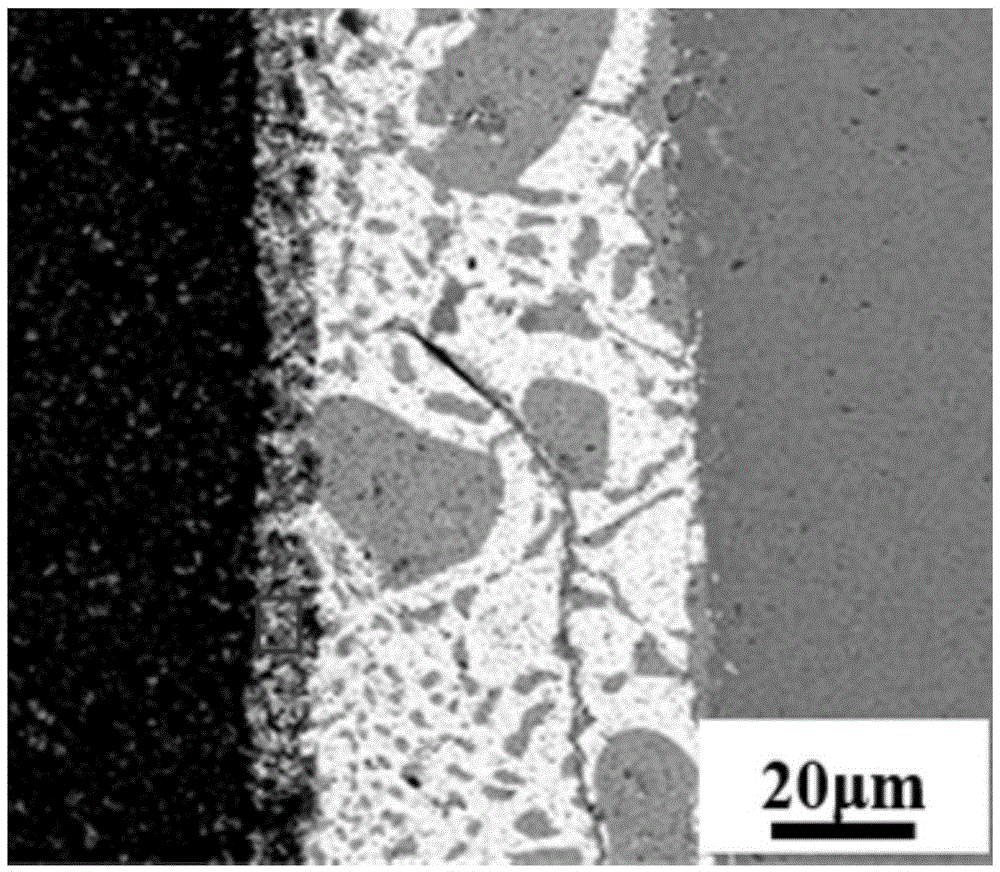Method for brazing porous Si3N4 ceramic and Invar alloy
An alloy and ceramic technology, applied in welding media, welding equipment, metal processing equipment, etc., can solve problems such as residual thermal stress, reduce joint strength, etc., and achieve the effect of improving joint performance and reliable joint.
- Summary
- Abstract
- Description
- Claims
- Application Information
AI Technical Summary
Problems solved by technology
Method used
Image
Examples
specific Embodiment approach 1
[0037] Specific implementation mode 1: Brazing porous Si in this implementation mode 3 N 4 The method of ceramic and Invar alloy is carried out according to the following steps:
[0038] 1. Put the polished Invar alloy and Cu foil into absolute ethanol, and ultrasonically clean it for 15 minutes;
[0039] 2. Mix the Ag-Cu-Ti solder with the binder, and then coat it on the porous Si 3 N 4 On the lower surface of the ceramic, mix the Ag-Cu solder with the binder, and then coat the upper surface of the Invar alloy, and then sandwich the Cu foil between the Ag-Cu-Ti solder and the Ag-Cu solder to obtain the sample ;
[0040] 3. Put the compact on the sample and put it in the vacuum sintering furnace. The vacuum degree is 6×10 -3 Under the condition of Pa, heat the sample to 300°C at a heating rate of 10°C / min and keep it warm for 10-30min, then heat the sample to 850-950°C at a heating rate of 10°C / min. ×10 3 Pa~4×10 3 Keep it warm for 20min under the condition of Pa, then...
specific Embodiment approach 2
[0041] Specific embodiment two: the difference between this embodiment and specific embodiment one is that the method of polishing Invar alloy in step one is as follows:
[0042]Use 400# metallographic sand, 800# metallographic sand, and 1200# metallographic sandpaper to polish the Invar alloy until the surface is bright without scratches. Others are the same as in the first embodiment.
specific Embodiment approach 3
[0043] Embodiment 3: The difference between this embodiment and Embodiment 1 or 2 is that the method of polishing the Cu foil in step 1 is as follows:
[0044] Use 400# metallographic sand, 800# metallographic sand, and 1200# metallographic sandpaper to polish the Cu foil until the surface is bright without scratches, and then use a diamond polishing agent with a particle size of 0.5 μm to polish the surface of the Cu foil until the surface No scratches under the microscope. Others are the same as those in the first or second embodiment.
PUM
| Property | Measurement | Unit |
|---|---|---|
| Granularity | aaaaa | aaaaa |
| Thickness | aaaaa | aaaaa |
| Thickness | aaaaa | aaaaa |
Abstract
Description
Claims
Application Information
 Login to View More
Login to View More - R&D
- Intellectual Property
- Life Sciences
- Materials
- Tech Scout
- Unparalleled Data Quality
- Higher Quality Content
- 60% Fewer Hallucinations
Browse by: Latest US Patents, China's latest patents, Technical Efficacy Thesaurus, Application Domain, Technology Topic, Popular Technical Reports.
© 2025 PatSnap. All rights reserved.Legal|Privacy policy|Modern Slavery Act Transparency Statement|Sitemap|About US| Contact US: help@patsnap.com



